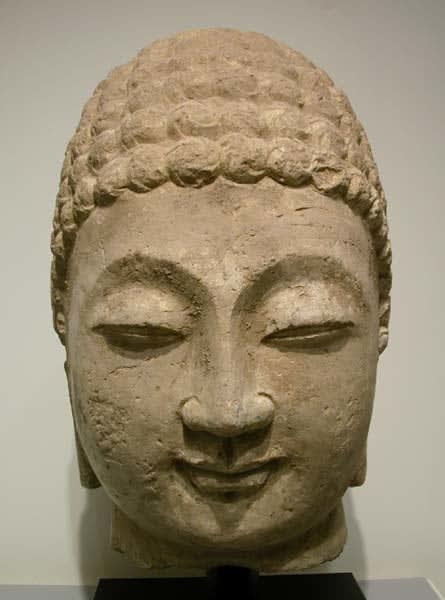Stone Buddha Head, 960 CE - 1279 CE
Stone
16
PF.5332
Further images
After the collapse of the Tang Dynasty (906 AD), there was a succession of short-lived governments (known as the Five Dynasties). This period of unrest came to an end with...
After the collapse of the Tang Dynasty (906 AD), there was a succession of short-lived governments (known as the Five Dynasties). This period of unrest came to an end with the establishment of the Northern Song Dynasty in 960 AD. Renewed political stability helped to usher in a period of economic prosperity and a massive rise in population. Amongst the many cultural achievements of the Song Dynasty, the re- invigoration of the examination system and the invention of movable type rank highly. Intellectually the greatest achievement was the development of Neo-Confucianism- a philosophical movement heavily influenced by Buddhist teachings. Although Buddhism had reached China from India during the Han Dynasty, it took time for the new faith to make progress. This was partly because it had to compete with native ideologies, namely Confucianism and Daoism. It was possible, however, to find common ground between these belief systems and by the Tang Dynasty Buddhism was experiencing a golden age in China.
A beautiful representation of Buddha with a tight-locked, swirl curl hairstyle, this piece exemplifies the rich iconographic world of Buddhism. Each curl contains a stylized version of the Buddhist symbol of the law 'which resembles a reversed swastika. The conical modeling of the. head allows the elaborate display of repetitious hair locks which is considered to be a special mark of a Buddha signifying his superior spiritual knowledge and achievement. Though exhibiting other Buddha-like features, such a pendulant earlobes and lines at the chin and neck, the cranial protruberance of knowledg and enlightenment, ushnisha, appears absent; it is perhaps suggested, however, in the conical formation of the head.
Sung period sculpture is characterized by monumental, blocky forms which convey the essence of heaviness, figuratively relating to one's profundity and resolve. Depicted in a state of meditation, the figure is given a full face, half-crescent eyes, long arche eyebrows, high-bridged nose. and small mouth. The state of calm is clearly conveyed through the Buddha's expression and energy which were intended to instruct and inspire us toward the path of enlightenment.
A beautiful representation of Buddha with a tight-locked, swirl curl hairstyle, this piece exemplifies the rich iconographic world of Buddhism. Each curl contains a stylized version of the Buddhist symbol of the law 'which resembles a reversed swastika. The conical modeling of the. head allows the elaborate display of repetitious hair locks which is considered to be a special mark of a Buddha signifying his superior spiritual knowledge and achievement. Though exhibiting other Buddha-like features, such a pendulant earlobes and lines at the chin and neck, the cranial protruberance of knowledg and enlightenment, ushnisha, appears absent; it is perhaps suggested, however, in the conical formation of the head.
Sung period sculpture is characterized by monumental, blocky forms which convey the essence of heaviness, figuratively relating to one's profundity and resolve. Depicted in a state of meditation, the figure is given a full face, half-crescent eyes, long arche eyebrows, high-bridged nose. and small mouth. The state of calm is clearly conveyed through the Buddha's expression and energy which were intended to instruct and inspire us toward the path of enlightenment.





